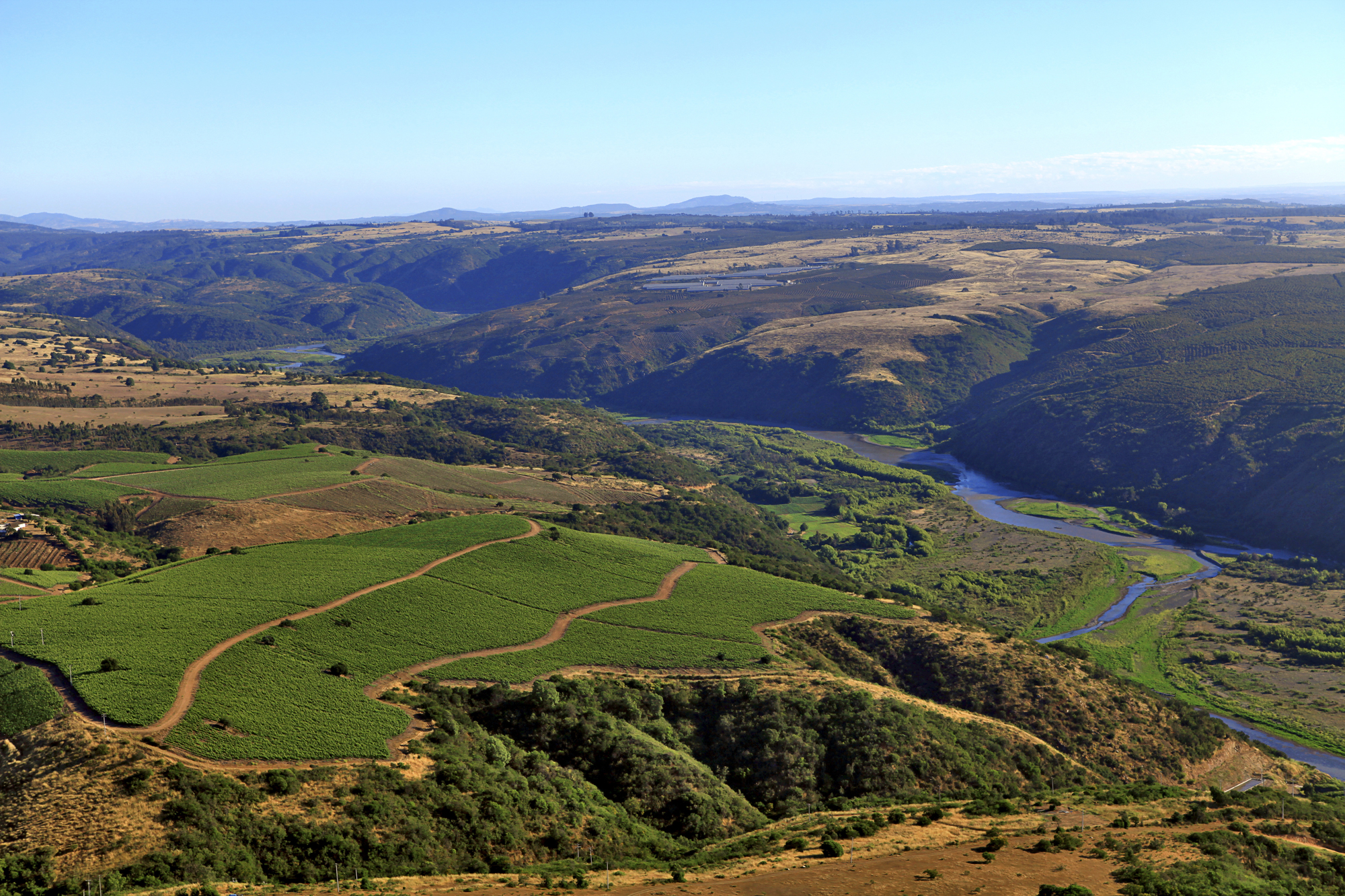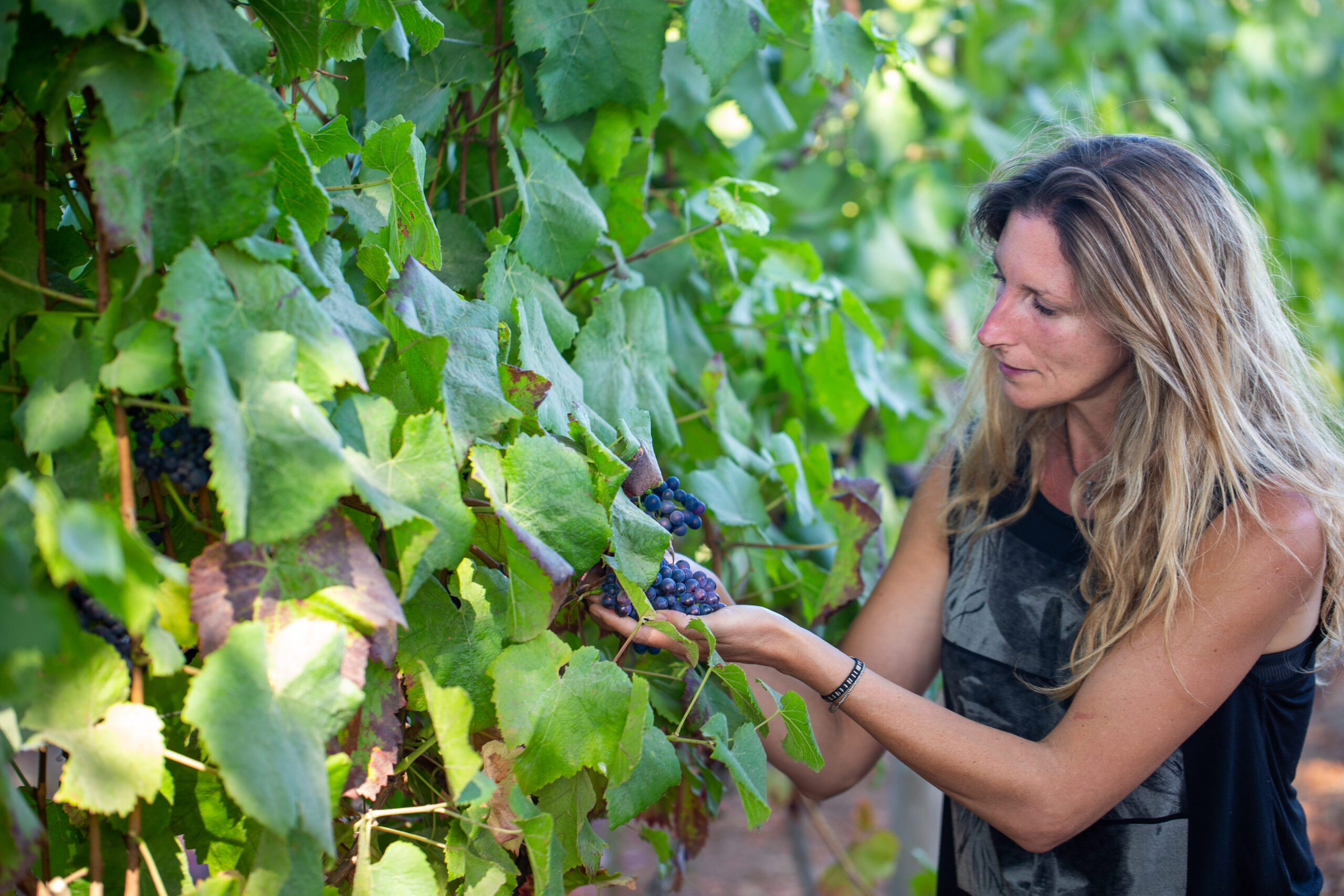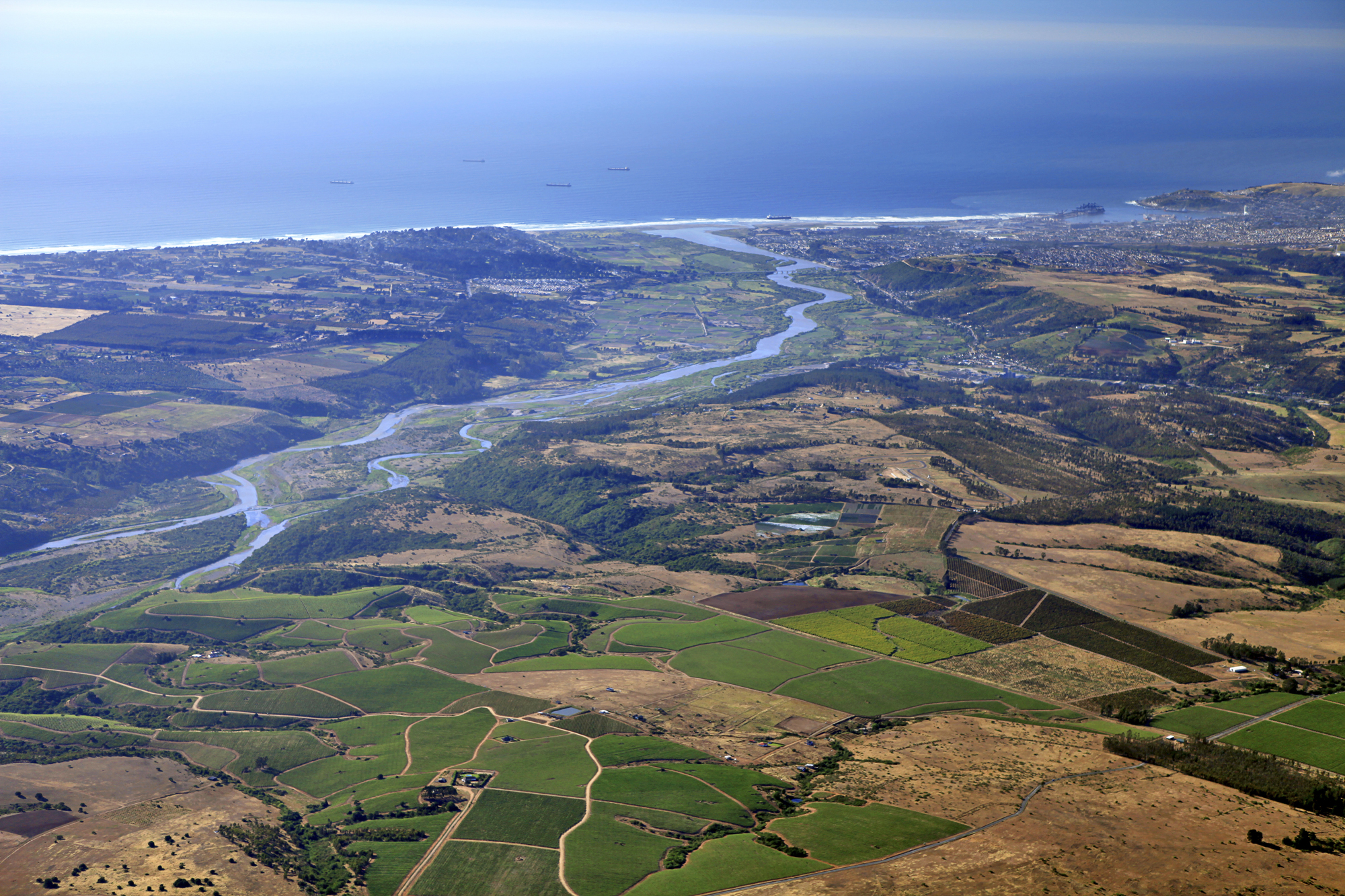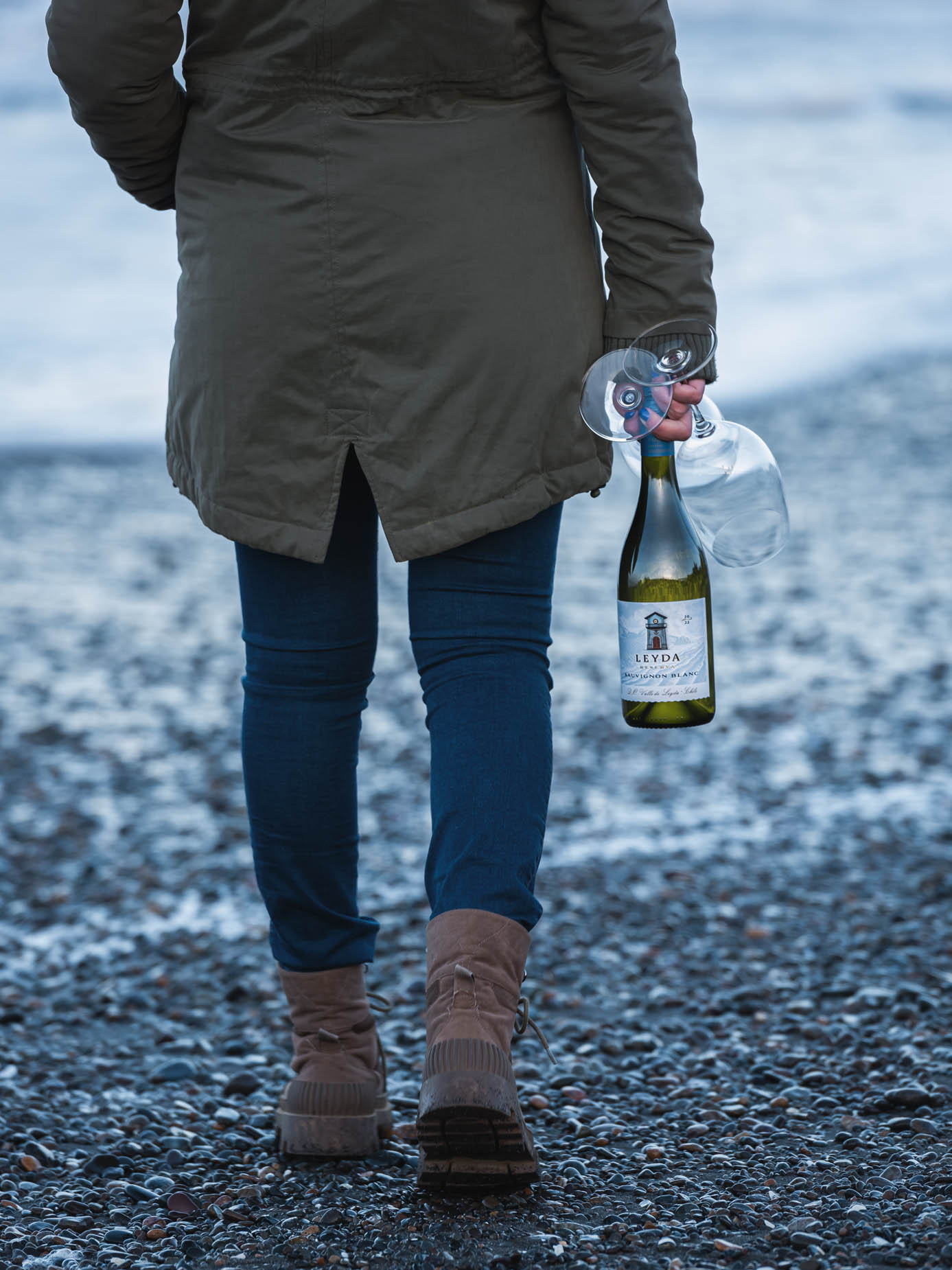The Elegant Wines of Viña Leyda
Made from grapes cooled by ocean breezes.

A striking feature of Chile’s Pacific Ocean beaches during the summer is that crowds bask in the sun on the golden sand, but relatively few people take to the inviting blue water. The reason is that the Humboldt Current, which runs north along Chile’s long coast, brings water with icy temperatures from the Southern (Antarctic) Ocean. Although the water off some northern beaches becomes a little more tolerable as the current warms, visitors to most of Chile’s beaches do no more than paddle in the ankle-deep shallows. As for surfers, they are advised to wear a full wetsuit, with hat and boots.
What’s inconvenient for would-be swimmers is a big plus for some vineyards close to the coast. Onshore breezes pick up the cold air above the current and have a notable cooling effect on the vines, offsetting the warmth of the sun during the growing season. Grapes in these air-conditioned vineyards develop not only the flavours and sugar they need but also good levels of natural acidity. Unlike many wines made from grapes grown in warm conditions, wines from these cooler sites do not need to be acidified to attain the freshness that makes them palatable.
Wine producers in Chile, where the best-known wine regions are located in warm river valleys, have sought out cooler growing conditions for years. Some plant vineyards up valley slopes to take advantage of lower temperatures at higher altitudes. But others have planted vineyards in areas close to the coast, in regions such as the Casablanca and San Antonio valleys, to benefit from the cooler air from the Pacific.


A small wine region in the San Antonio Valley is Leyda Valley, and the first winery established there was Viña Leyda, its vineyards located only four kilometres from the coast. In the mornings, the vines are enveloped in mist and conditions are damp. Viña Leyda’s winemaker, Viviana Navarrete, says that after walking through the vineyards in the morning, “my sneakers are totally wet.” But an ocean breeze blows in every day at about 2 p.m.—you can feel the cool air on your face as you look toward the coast—drying the vines and tempering the afternoon heat. When the temperature is 28°C in Maipo Valley, which is famed for cabernet sauvignon, it is only 21° in Leyda Valley.
Viña Leyda began to plant vines in 1998, and made its first wines in 2002, the same year that Leyda Valley was given recognition as a Denominación de Origen (DO), an officially recognized appellation. The valley has attracted other producers since then—there are now seven wineries and five grape growers—and it has established a reputation for high-quality wines.
Thanks to the ocean influence, Leyda Valley is a resolutely cool-climate region. Viviana Navarrete sources grapes from warmer regions for some of her wines, but she says of the Leyda Valley, “There is no cabernet sauvignon, no carmenère here.” Three-quarters of the wine she makes is from pinot noir or sauvignon blanc, with the rest being chardonnay (including a traditional method sparkling wine), riesling, pinot gris, and syrah. Navarrete, who has made the wine at Viña Leyda since 2007 and so knows the Leyda Valley well, says they tried merlot but “it was awful—very green.” She would like to broaden her portfolio and hopes to do trials with varieties that perform well in cool conditions, such as grenache, cabernet franc, and albariño.
Viviana Navarrete is a much-lauded winemaker who is a regular on lists of Chile’s best winemakers. Among recent accolades: she was included among the best pinot noir winemakers in Chile by Wine Spectator magazine in 2017; she was named winemaker of the year by prominent British wine critic Tim Atkin MW in his Chile Report 2020; and she was the only South American winemaker in Wine Enthusiast magazine’s list of the 13 best women winemakers in the world in 2020.


But Navarrete is not resting on her laurels. She has set out to become an expert on pinot noir, and although some would say her elegant pinots show she is there already, she is not satisfied. She says it is a “huge challenge” to produce pinot with the texture and herbal and fruit aromatics she strives for. Since becoming Viña Leyda’s winemaker, she has reduced the influence of oak and careful vine management has lowered the alcohol level of her pinot noirs from over 14 per cent to between 12.5 and 13.3 per cent.
Viviana Navarrete’s current pinot noirs show a common style of vibrant acidity, well-defined and focused flavours, and a fresh, juicy texture. They reflect her aim to “forget creaminess and look for elegance and finesse in sinewy wines with a backbone of acidity.” She sees her wines in the broader context of Chilean pinot noirs. In the past, she says, “there were many awful examples,” often the result of too much oak, but now the quality is far better. Viña Leyda’s pinot noirs are in the style increasingly popular today: less driven by fruit but more structured and lighter on their feet.
Some of the winery’s other wines embody this style, too. There are sauvignon blancs with juicy, crunchy acidity and bright flavours led by citrus fruit. But others show a little more textural weight from partial fermentation in large barrels, while yet others are fermented in concrete vats. As for the syrahs, they show a linear style—definitively cool-climate—with fresh acidity and flavours of red fruit, spices, and white pepper.
Skilled vineyard management and winemaking always lie behind fine wines, and Viña Leyda’s reds and whites are no exception. But the contribution of the growing conditions is perhaps clearer here than in many other locations. The cold ocean current and the cool onshore breezes might not invite swimming, but they provide a perfect canvas for Viviana Navarrete to fashion elegant pinot noirs and other wines.
Some Viña Leyda wines
Leyda Coastal Vineyards-Cahuil Pinot Noir 2019
Leyda Coastal Vineyards-Garumas Sauvignon Blanc 2021
Leyda Coastal Vineyards-Kadún Sauvignon Gris 2021
Leyda Lot 21 Pinot Noir 2019
Leyda Reserva Sauvignon Blanc 2021




